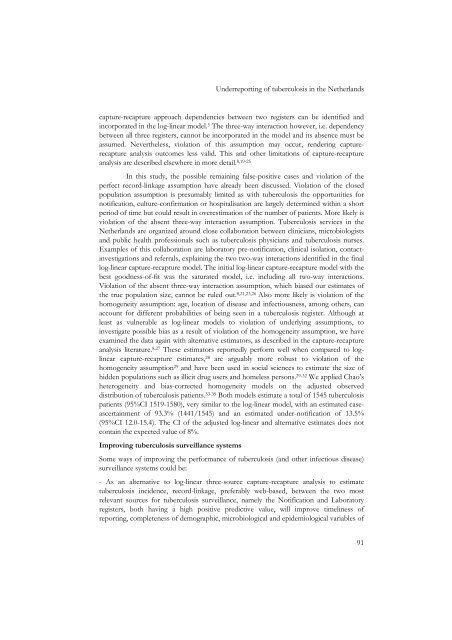Rob van Hest Capture-recapture Methods in Surveillance - RePub ...
Rob van Hest Capture-recapture Methods in Surveillance - RePub ...
Rob van Hest Capture-recapture Methods in Surveillance - RePub ...
Create successful ePaper yourself
Turn your PDF publications into a flip-book with our unique Google optimized e-Paper software.
Underreport<strong>in</strong>g of tuberculosis <strong>in</strong> the Netherlands<br />
capture-<strong>recapture</strong> approach dependencies between two registers can be identified and<br />
<strong>in</strong>corporated <strong>in</strong> the log-l<strong>in</strong>ear model. 5 The three-way <strong>in</strong>teraction however, i.e. dependency<br />
between all three registers, cannot be <strong>in</strong>corporated <strong>in</strong> the model and its absence must be<br />
assumed. Nevertheless, violation of this assumption may occur, render<strong>in</strong>g capture<strong>recapture</strong><br />
analysis outcomes less valid. This and other limitations of capture-<strong>recapture</strong><br />
analysis are described elsewhere <strong>in</strong> more detail. 8,19-25<br />
In this study, the possible rema<strong>in</strong><strong>in</strong>g false-positive cases and violation of the<br />
perfect record-l<strong>in</strong>kage assumption have already been discussed. Violation of the closed<br />
population assumption is presumably limited as with tuberculosis the opportunities for<br />
notification, culture-confirmation or hospitalisation are largely determ<strong>in</strong>ed with<strong>in</strong> a short<br />
period of time but could result <strong>in</strong> overestimation of the number of patients. More likely is<br />
violation of the absent three-way <strong>in</strong>teraction assumption. Tuberculosis services <strong>in</strong> the<br />
Netherlands are organized around close collaboration between cl<strong>in</strong>icians, microbiologists<br />
and public health professionals such as tuberculosis physicians and tuberculosis nurses.<br />
Examples of this collaboration are laboratory pre-notification, cl<strong>in</strong>ical isolation, contact<strong>in</strong>vestigations<br />
and referrals, expla<strong>in</strong><strong>in</strong>g the two two-way <strong>in</strong>teractions identified <strong>in</strong> the f<strong>in</strong>al<br />
log-l<strong>in</strong>ear capture-<strong>recapture</strong> model. The <strong>in</strong>itial log-l<strong>in</strong>ear capture-<strong>recapture</strong> model with the<br />
best goodness-of-fit was the saturated model, i.e. <strong>in</strong>clud<strong>in</strong>g all two-way <strong>in</strong>teractions.<br />
Violation of the absent three-way <strong>in</strong>teraction assumption, which biased our estimates of<br />
the true population size, cannot be ruled out. 8,21,23,26 Also more likely is violation of the<br />
homogeneity assumption: age, location of disease and <strong>in</strong>fectiousness, among others, can<br />
account for different probabilities of be<strong>in</strong>g seen <strong>in</strong> a tuberculosis register. Although at<br />
least as vulnerable as log-l<strong>in</strong>ear models to violation of underly<strong>in</strong>g assumptions, to<br />
<strong>in</strong>vestigate possible bias as a result of violation of the homogeneity assumption, we have<br />
exam<strong>in</strong>ed the data aga<strong>in</strong> with alternative estimators, as described <strong>in</strong> the capture-<strong>recapture</strong><br />
analysis literature. 8,27 These estimators reportedly perform well when compared to logl<strong>in</strong>ear<br />
capture-<strong>recapture</strong> estimates, 28 are arguably more robust to violation of the<br />
homogeneity assumption29 and have been used <strong>in</strong> social sciences to estimate the size of<br />
hidden populations such as illicit drug users and homeless persons. 29-32 We applied Chao’s<br />
heterogeneity and bias-corrected homogeneity models on the adjusted observed<br />
distribution of tuberculosis patients. 33-35 Both models estimate a total of 1545 tuberculosis<br />
patients (95%CI 1519-1580), very similar to the log-l<strong>in</strong>ear model, with an estimated caseascerta<strong>in</strong>ment<br />
of 93.3% (1441/1545) and an estimated under-notification of 13.5%<br />
(95%CI 12.0-15.4). The CI of the adjusted log-l<strong>in</strong>ear and alternative estimates does not<br />
conta<strong>in</strong> the expected value of 8%.<br />
Improv<strong>in</strong>g tuberculosis surveillance systems<br />
Some ways of improv<strong>in</strong>g the performance of tuberculosis (and other <strong>in</strong>fectious disease)<br />
surveillance systems could be:<br />
- As an alternative to log-l<strong>in</strong>ear three-source capture-<strong>recapture</strong> analysis to estimate<br />
tuberculosis <strong>in</strong>cidence, record-l<strong>in</strong>kage, preferably web-based, between the two most<br />
rele<strong>van</strong>t sources for tuberculosis surveillance, namely the Notification and Laboratory<br />
registers, both hav<strong>in</strong>g a high positive predictive value, will improve timel<strong>in</strong>ess of<br />
report<strong>in</strong>g, completeness of demographic, microbiological and epidemiological variables of<br />
91

















